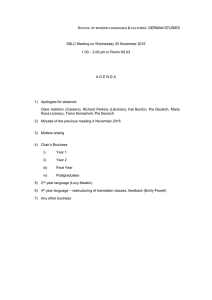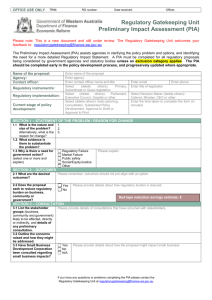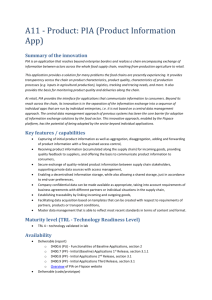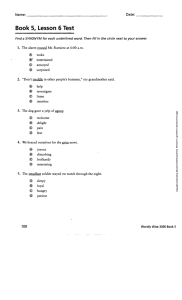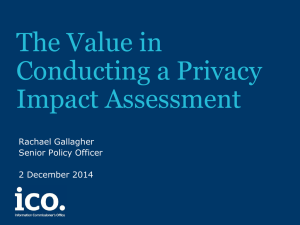Response Time Aware Coordination in Multi Agent Filtering Framework
advertisement
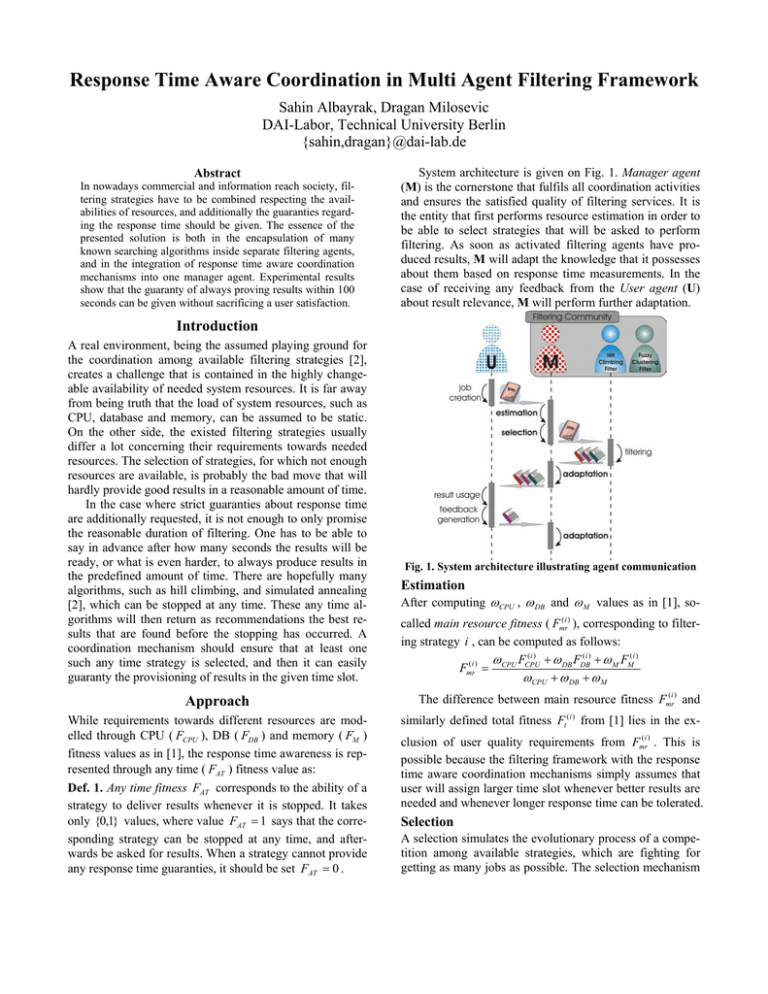
Response Time Aware Coordination in Multi Agent Filtering Framework
Sahin Albayrak, Dragan Milosevic
DAI-Labor, Technical University Berlin
{sahin,dragan}@dai-lab.de
Abstract
In nowadays commercial and information reach society, filtering strategies have to be combined respecting the availabilities of resources, and additionally the guaranties regarding the response time should be given. The essence of the
presented solution is both in the encapsulation of many
known searching algorithms inside separate filtering agents,
and in the integration of response time aware coordination
mechanisms into one manager agent. Experimental results
show that the guaranty of always proving results within 100
seconds can be given without sacrificing a user satisfaction.
System architecture is given on Fig. 1. Manager agent
(M) is the cornerstone that fulfils all coordination activities
and ensures the satisfied quality of filtering services. It is
the entity that first performs resource estimation in order to
be able to select strategies that will be asked to perform
filtering. As soon as activated filtering agents have produced results, M will adapt the knowledge that it possesses
about them based on response time measurements. In the
case of receiving any feedback from the User agent (U)
about result relevance, M will perform further adaptation.
Introduction
A real environment, being the assumed playing ground for
the coordination among available filtering strategies [2],
creates a challenge that is contained in the highly changeable availability of needed system resources. It is far away
from being truth that the load of system resources, such as
CPU, database and memory, can be assumed to be static.
On the other side, the existed filtering strategies usually
differ a lot concerning their requirements towards needed
resources. The selection of strategies, for which not enough
resources are available, is probably the bad move that will
hardly provide good results in a reasonable amount of time.
In the case where strict guaranties about response time
are additionally requested, it is not enough to only promise
the reasonable duration of filtering. One has to be able to
say in advance after how many seconds the results will be
ready, or what is even harder, to always produce results in
the predefined amount of time. There are hopefully many
algorithms, such as hill climbing, and simulated annealing
[2], which can be stopped at any time. These any time algorithms will then return as recommendations the best results that are found before the stopping has occurred. A
coordination mechanism should ensure that at least one
such any time strategy is selected, and then it can easily
guaranty the provisioning of results in the given time slot.
Approach
While requirements towards different resources are modelled through CPU ( FCPU ), DB ( FDB ) and memory ( FM )
fitness values as in [1], the response time awareness is represented through any time ( FAT ) fitness value as:
Def. 1. Any time fitness FAT corresponds to the ability of a
strategy to deliver results whenever it is stopped. It takes
only {0,1} values, where value FAT = 1 says that the corresponding strategy can be stopped at any time, and afterwards be asked for results. When a strategy cannot provide
any response time guaranties, it should be set FAT = 0 .
Fig. 1. System architecture illustrating agent communication
Estimation
After computing ωCPU , ω DB and ω M values as in [1], socalled main resource fitness ( Fmr(i ) ), corresponding to filtering strategy i , can be computed as follows:
(i )
ω F ( i ) + ω DB FDB
+ ω M FM( i )
Fmr( i ) = CPU CPU
ω CPU + ω DB + ω M
The difference between main resource fitness Fmr(i ) and
similarly defined total fitness Ft (i ) from [1] lies in the exclusion of user quality requirements from Fmr(i ) . This is
possible because the filtering framework with the response
time aware coordination mechanisms simply assumes that
user will assign larger time slot whenever better results are
needed and whenever longer response time can be tolerated.
Selection
A selection simulates the evolutionary process of a competition among available strategies, which are fighting for
getting as many jobs as possible. The selection mechanism
should establish not only a fair fight among them, but also
should ensure that at least one any time strategy will get a
filtering job. That any time strategy should serve as a guarantee that results will be ready on time, being the essential
property of this response time aware coordination. The fair
fight is realised through the application of proportional
selection [2], which specifies that the selection probability
Py( i ) for strategy i is proportional to its fitness value, i.e.
(i )
y
P
n
= F ∑ Fy( j )
j =1
−1
(i )
y
As a fitness value Fy(i ) , the already introduced Fmr(i ) is
used in the main selection step. In the case where selected
( j)
strategy j has FAT
= 1 , selection is finished because this
any time strategy can give necessary response time guaran( j)
ties. Otherwise, when it holds FAT
= 0 , it is needed additionally to find one any time strategy that can hopefully
work well together with the already selected strategy j .
This is achieved by defining alternative resource fitness
value Far( i , j ) for all strategies i ( i ≠ j ) relative to j , as:
(i ) (i , j ) (i )
Far( i , j ) = FAT
rp Fmr
After Far( i , j ) is computed, it is used as Fy(i ) in the alternative selection step, which will always select one any time
strategy. All not any time strategies will have Far( i , j ) = 0 ,
and therefore they will be without chances to be selected.
Not each and every two strategies can successfully
work together. Maybe they both depend on the same resource, which cannot effectively support both of them at
the same time. The effect of being able to successfully collaborate is modelled through strategy pair reliability rp( i , j ) ,
being included in Far( i , j ) computation. Value rp( i , j ) shows
how particular strategy pair (i, j ) was successful in the
past in delivering results that users like. It is assumed that
when two strategies collaborate well, the available resources will be successfully exploited, and hopefully good
results will be found. Such two strategies should have large
rp( i , j ) value, which will facilitate their selection in the future. The low pair successfulness in the past will result in a
small rp( i , j ) , which will reduce Far( i , j ) and accordingly will
diminish chances that the same pair will again collaborate.
Adaptation
(i )
(i )
While the adaptation of FCPU
, FDB
and FM(i ) values has
been discussed in [1], rp( i , j ) value is adapted based on the
received actual feedback qa as:
( new ) ( i , j )
p
r
q
= ( old ) rp( i , j ) a
ε
l (t )
Value qa corresponds to the quality of a result that was
found when strategies i and j worked together, ε is a
tolerance that defines how good feedback should be in order to get a reward, and l (t ) = l0 e − βt is a learning rate.
Experimental Results
As a test environment, PIA system is used because it actively helps to 26 DAI Labor workers in their information
retrieval activities. Starting from 27th of September 2004,
the following 4 coordination schemes were tested. The first
3 days PIA was working without resource aware coordination (PIA I), the next 3 days pure resource aware coordination was plugged in PIA (PIA II), and the last two, 3 day
long, PIA configurations are based on a response time
aware coordination, where one assigns 100s (PIA III) and
the other 20s (PIA IV) as the time slot. It is noticed that not
taking care about resources while doing coordination will
produce long-lasting filtering jobs [1]. A resource aware
coordination is managing to eliminate these long-lasting
jobs, but without giving the strict response time guaranties.
The obtained user feedback values are given in Table 1.
While the feedback values are comparable for PIA I, PIA
II and PIA III systems, a significant decrease is noticed
when a response time aware coordination with 20s time
slot is used (PIA IV). Setting a realistically big time slot,
such as 100s, will not reduce a feedback value (PIA III),
which proves that the response time aware coordination
can be used without sacrificing a user satisfaction.
Received feedback PIA I PIA II PIA III PIA IV
Very good
7
13
11
2
Good
19
15
16
12
Bad
4
6
4
15
Very bad
4
3
5
9
Table 1. Received feedback values for different PIA systems
Users are not ready to pay unreasonably high price for
the reduction of a filtering time, but they are willing to wait
little longer in order to get better recommendations. The
advantage of the response time aware coordination mechanisms is contained in the fact that users can known in advance how long at most they have to wait for the results.
Conclusion
The presented solution is trying not only to eliminate longlasting filtering jobs, but also to give guaranties regarding
the response time. Even though the realised coordination
mechanisms are generic, which treat filtering jobs as black
boxes, future work will be concentrated on taking into account also the properties of jobs while doing estimation.
References
[1] Albayrak, S; Milosevic, D. 2004. Self Improving Coordination in Multi Agent Filtering Framework. IEEE/WIC/ACM Conference on IAT and WI, China.
[2] Michalewicz, Z.; Fogel, D. 2000. How to Solve It: Modern
Heuristics. Springer-Verlag New York, Inc., NY.
